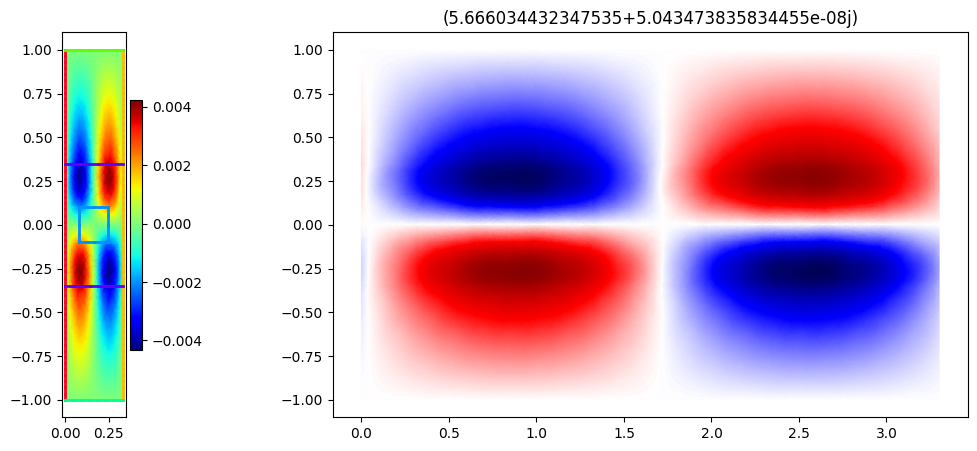Bragg filter#
Reproducing an example of [1] (and soon [2])
height = 1
a = 0.330
b = 0.7
c = 0.2
k0 = 0.7 / a # 1.05/a
left = shapely.LineString([(0, y) for y in np.linspace(-height, height, 20)])
right = shapely.LineString([(a, y) for y in np.linspace(-height, height, 20)])
top = shapely.LineString([(x, height) for x in np.linspace(0, a, 2)])
bottom = shapely.LineString([(x, -height) for x in np.linspace(0, a, 2)])
box = shapely.box(0, -height, a, height)
structure = shapely.box(0, -b / 2, a, b / 2)
hole = shapely.box(a / 4, -c / 2, a / 4 * 3, c / 2)
resolutions = {"hole": {"resolution": 0.1, "distance": 1}}
mesh = from_meshio(
mesh_from_OrderedDict(
OrderedDict(
left=left,
right=right,
top=top,
bottom=bottom,
hole=hole,
structure=structure,
box=box,
),
resolutions=resolutions,
filename="mesh.msh",
default_resolution_max=0.05,
periodic_lines=[("left", "right")],
)
)
basis_epsilon_r = Basis(mesh, ElementTriP0(), intorder=4)
epsilon_r = basis_epsilon_r.zeros(dtype=np.complex64) + 1.45
epsilon_r[basis_epsilon_r.get_dofs(elements="structure")] = 3.5
epsilon_r **= 2
basis_epsilon_r.plot(np.real(epsilon_r), ax=mesh.draw(), colorbar=True).show()
ks, basis_phi, phis = solve_periodic(basis_epsilon_r, epsilon_r, k0)
idx = np.abs(np.imag(ks * a)) < 0.5
ks = ks[idx]
phis = phis[:, idx]
# print(ks)
# plt.plot(np.real(ks))
# plt.plot(np.imag(ks))
# plt.show()
for i, k in enumerate(ks):
fig, axs = plt.subplots(1, 2, figsize=(13, 5), gridspec_kw={"width_ratios": [1, 10]})
mesh.draw(ax=axs[0], boundaries=True, boundaries_only=True)
basis_phi.plot(np.real(phis[..., i]), shading="gouraud", colorbar=True, ax=axs[0])
axs[0].set_aspect(1)
plt.title(f"{k*a}")
# axs[0].set_aspect(1)
plot_periodic(k, a, basis_phi, phis[..., i], 10, axs[1])
plt.show()







Bibliography#
[1]
Jelena Notaros and Miloš A. Popović. Finite-difference complex-wavevector band structure solver for analysis and design of periodic radiative microphotonic structures. Optics Letters, 40(6):1053, March 2015. URL: https://doi.org/10.1364/ol.40.001053, doi:10.1364/ol.40.001053.
[2]
Chris Fietz, Yaroslav Urzhumov, and Gennady Shvets. Complex k band diagrams of 3d metamaterial/photonic crystals. Optics Express, 19(20):19027, September 2011. URL: http://dx.doi.org/10.1364/OE.19.019027, doi:10.1364/oe.19.019027.